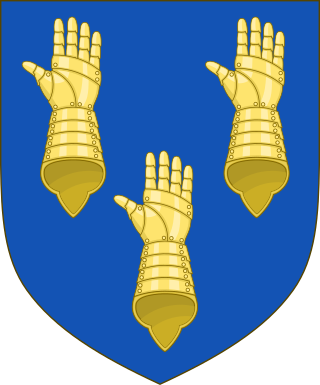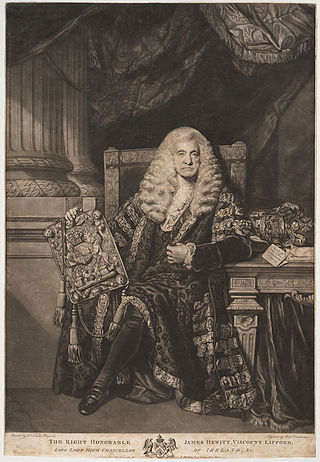Related Research Articles

Baron Inglewood, of Hutton in the Forest in the County of Cumberland, is a title in the Peerage of the United Kingdom.

Marquess of Londonderry, of the County of Londonderry, is a title in the Peerage of Ireland.
The title of Viscount Mountjoy has been created three times, twice in the Peerage of Ireland and once in the Peerage of Great Britain. The creations in the Peerage of Ireland were made in 1683 and 1795, and became extinct in 1769 and 1829, respectively. The creation in the Peerage of Great Britain occurred in 1796, as a subsidiary title for the Marquess of Bute, to which title it is still attached.

Earl of Mount Edgcumbe is a title in the Peerage of Great Britain. It was created in 1789 for George Edgcumbe, 3rd Baron Edgcumbe. This branch of the Edgcumbe family descends from Sir Piers Edgcumbe of Cotehele in Cornwall, who acquired an estate near Plymouth through marriage in the early 16th century, which was later re-named "Mount Edgcumbe". His descendant Richard Edgcumbe was a prominent politician and served as Paymaster-General of Ireland and as Chancellor of the Duchy of Lancaster. In 1742, he was created Baron Edgcumbe, of Mount Edgcumbe in the County of Devon, in the Peerage of Great Britain. Richard Edgcumbe was succeeded by his eldest son, the second Baron. He represented Plympton Erle, Lostwithiel and Penrhyn in the House of Commons and served as Lord-Lieutenant of Cornwall. On his death, the title passed to his younger brother, the third Baron. He was an Admiral of the Blue and also held political office as Treasurer of the Household and as Captain of the Honourable Band of Gentlemen Pensioners. In 1781, he was created Viscount Mount Edgcumbe and Valletort and in 1789 he was further honoured when he was made Earl of Mount Edgcumbe. Both titles are in the Peerage of Great Britain.

Baron Barnard, of Barnard Castle in the Bishopric of Durham, is a title in the Peerage of England. It was created in 1698 for Christopher Vane, who had previously served as a member of parliament for County Durham and Boroughbridge. Vane was the son of Sir Henry Vane the Younger and grandson of Sir Henry Vane the Elder. His grandson, the third Baron, notably served as Paymaster of the Forces and as Lord Lieutenant of County Durham. In 1754 he was created Viscount Barnard and Earl of Darlington, both in the County Palatine of Durham. Lord Darlington was the husband of Lady Grace FitzRoy, daughter of Charles FitzRoy, 2nd Duke of Cleveland, the illegitimate son of King Charles II by his mistress Barbara Villiers, 1st Duchess of Cleveland.

Earl of Enniskillen is a title in the Peerage of Ireland. It was created in 1789 for William Cole, 1st Viscount Enniskillen. He had already been created Viscount Enniskillen in the Peerage of Ireland in 1776 and had inherited the title Baron Mountflorence, of Florence Court in the County of Fermanagh, which had been created in the Peerage of Ireland in 1760 for his father John Cole, who had earlier represented Enniskillen in the Irish House of Commons. The family are descended from the Ulster planter, Sir William Cole.

Earl of Bessborough is a title in the Peerage of Ireland. It was created in 1739 for Brabazon Ponsonby, 2nd Viscount Duncannon, who had previously represented Newtownards and County Kildare in the Irish House of Commons. In 1749, he was given the additional title of Baron Ponsonby of Sysonby, in the County of Leicester, in the Peerage of Great Britain, which entitled him to a seat in the British House of Lords. The titles Viscount Duncannon, of the fort of Duncannon in the County of Wexford, and Baron Bessborough, of Bessborough, Piltown, in the County of Kilkenny, had been created in the Peerage of Ireland in 1723 and 1721 respectively for Lord Bessborough's father William Ponsonby, who had earlier represented County Kilkenny in the Irish House of Commons.

Earl Annesley, of Castlewellan in the County of Down, is a title in the Peerage of Ireland. It was created on 17 August 1789 for Francis Annesley, 2nd Viscount Glerawly, with special remainder to his younger brother the Honourable Richard Annesley. He had previously represented Downpatrick in the Irish House of Commons. The titles of Baron Annesley, of Castlewellan in the County of Down, and Viscount Glerawly, in the County of Fermanagh, were created in the Peerage of Ireland on 20 September 1758 and 14 November 1766 respectively for his father William Annesley, who sat as Member of the Irish Parliament for Midleton. Annesley was the sixth son of the Honourable Francis Annesley, fourth son of Francis Annesley, 1st Viscount Valentia.

Earl of Antrim is a title that has been created twice, both times in the Peerage of Ireland and both times for members of the MacDonnell family, originally of Scottish origins.

Viscount Gormanston is a title in the Peerage of Ireland created in 1478 and held by the head of the Preston family, which hailed from Lancashire. It is the oldest vicomital title in the British Isles; the holder is Premier Viscount of Ireland.

Viscount Charlemont is a title in the Peerage of Ireland. It was created in 1665 for William Caulfeild, 5th Baron Charlemont.

Viscount Boyne, in the province of Leinster, is a title in the Peerage of Ireland. It was created in 1717 for the Scottish military commander Gustavus Hamilton, 1st Baron Hamilton of Stackallan. He had already been created Baron Hamilton of Stackallan, in the County of Meath in 1715, also in the Peerage of Ireland. Hamilton was the youngest son of Sir Frederick Hamilton, youngest son of Claud Hamilton, 1st Lord Paisley, third son of James Hamilton, 2nd Earl of Arran. His grandson, the second Viscount, represented Newport in the House of Commons. His first cousin, the fourth Viscount, sat as a member of the Irish House of Commons for Navan.

Viscount Lifford is a title in the Peerage of Ireland. It was created in 1781 for James Hewitt, 1st Baron Lifford, the Lord Chancellor of Ireland. He had already been created Baron Lifford, of Lifford in the County of Donegal, in 1768, also in the Peerage of Ireland. He was succeeded by his son, the second Viscount, who was Dean of Armagh from 1796 to 1830. His grandson, the fourth Viscount, sat in the House of Lords as an Irish representative peer from 1856 to 1887. His younger son, the sixth Viscount, was a captain in the Royal Navy. His son, the seventh Viscount, fought in both the Second Boer War and the First World War. He was succeeded by his cousin, the eighth Viscount. He was the son of the Hon. George Wyldbore Hewitt, seventh son of the fourth Viscount. As of 2014 the titles are held by his son, the ninth Viscount, who succeeded in 1987.

Viscount Esher, of Esher in the County of Surrey, is a title in the Peerage of the United Kingdom. It was created on 11 November 1897 for the prominent lawyer and judge William Brett, 1st Baron Esher, upon his retirement as Master of the Rolls. He had already been created Baron Esher, of Esher in the County of Surrey, on 24 July 1885, also in the Peerage of the United Kingdom. His son, the second Viscount, was a Liberal politician and historian. His grandson, the fourth Viscount, was a noted architect. As of 2010 the titles are held by the latter's son, the fifth Viscount, who succeeded in 2004.

Baron Farnham, of Farnham in the County of Cavan, is a title in the Peerage of Ireland. It was created in 1756 for John Maxwell, who had previously represented Cavan Borough in the Irish House of Commons. John Maxwell's son, the second Baron, was created Viscount Farnham in 1760 and Earl of Farnham in 1763. Both titles were in the Peerage of Ireland but became extinct when he died childless in 1779. His brother and successor, the third Baron, was again created Viscount Farnham in 1781 and Earl of Farnham in 1785. These titles were also in the Peerage of Ireland. His son, the second Earl, sat in the House of Lords as an Irish representative peer from 1816 to 1823. However, he had no children and on his death in 1823 the viscountcy and earldom became extinct.

Duke of Cleveland was a title that was created twice, once in the Peerage of England and once in the Peerage of the United Kingdom. The dukedoms were named after Cleveland in northern England.

Earl of Clanricarde is a title that has been created twice in the Peerage of Ireland, first in 1543 and again in 1800. The former creation became extinct in 1916 while the 1800 creation is extant and held by the Marquess of Sligo since 1916.

Henry Vane, 1st Earl of Darlington, PC, known as Lord Barnard between 1753 and 1754, was a British politician who sat in the House of Commons from 1726 to 1753 when he succeeded to a peerage as Baron Barnard.

William Morgan Fletcher-Vane, 1st Baron Inglewood, TD, was a British Conservative Party politician.
William Vane, 1st Viscount Vane, of Fairlawn, Kent, was a British Whig politician who sat in the House of Commons between 1708 and 1734.